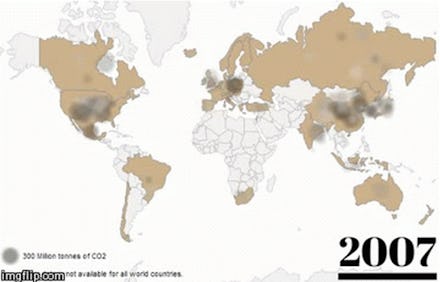Over the Last 43 Years, Here's How Much Pollution We've Put Into the Air

While pollution and its effect on climate change may be international problems, not all countries are equally at fault.
Despite the changing international landscape and the rise of powerful industrial economies such in India and Russia, nearly half of the world's CO2 emissions can be squarely blamed on two countries: the U.S. and China.
The latter firmly cemented its leading status in 2007, although the U.S. emission levels are not looking any lower. Here is a map illustrating just how much CO2 emission these two countries dump on the rest of the world:
Image Credit: The Atlantic Cities/visualizing.org
Carbon emissions have been on the rise since 1971, with a steady annual increase of 2%. The global output is expected to rise by another 39% by 2030. In the U.S. alone, CO2 emissions have increased by 10% between 1999 and 2011.
How does that look compared to the rest of the world? Surprisingly enough, the global landscape of carbon emission has not changed much over the years. Here's a GIF simulating CO2 output in 1971:
Image Credit: The Atlantic Cities/visualizing.org
Most of the carbon emissions are concentrated in North America, Europe and East Asia, with the only noticeable outlier being South Africa.
Now here is a version that illustrates how the carbon outputs look in 2011:
Image Credit: The Atlantic Cities/visualizing.org
The most obvious increase is in China, which is covered by the CO2 clouds. Other countries that increased their presence on the map include Russia, Brazil, Turkey, India and Australia, while western Europe significantly cut down its output. But other than a few noticeable additions and eliminations, the distribution of carbon emission across the world looks remarkably similar to how it did back in 1971.
In pie chart form, it becomes even more telling just how much impact the U.S. and China's CO2 dump has on the rest of the world:
Image Credit: EPA
In 2008, U.S. CO2 output was equal to India and 24 EU countries' combined output. As for China, it emitted as much CO2 as the U.S. and Japan combined.
China has been under a ton of pressure to deal with its insane air pollution problem, and it looks like its emissions may finally be slowing down. It's also drafting a comprehensive climate change bill to reform its energy policy. Chinese officials are considering a carbon tax, and by 2040, they want to reduce CO2 output by 40% of the 2005 levels.
But no matter how many doomsday scenarios are foretold, the U.S. remains frustratingly slow on curbing down carbon emission. Despite improved energy efficiency and increased popularity of alternative energy sources, the U.S. ended its recent CO2 decline streak with a 2% increase in 2013. But what can you expect from a country where politicians want to censor science and stop students from learning about climate change?